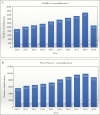Drugs for Gram-Negative Bugs From 2010-2019: A Decade in Review
- PMID: 32760748
- PMCID: PMC7393798
- DOI: 10.1093/ofid/ofaa276
Drugs for Gram-Negative Bugs From 2010-2019: A Decade in Review
Abstract
A literature review spanning January 1, 2010, to December 31, 2019, was conducted using the PubMed and ISI Web of Science databases to determine the breadth of publication activity in the area of gram-negative bacteria antimicrobial therapy. The number of articles was used as a reflection of scholarly activity. First, PubMed was searched using the following Medical Subject Headings (MeSH): antibacterial agents, Enterobacteriaceae, Acinetobacter, and Pseudomonas. A total of 12 643 articles were identified within PubMed, and 77 862 articles were identified within ISI Web of Science that included these terms. Second, these articles were categorized by antibiotic class to identify relative contributions to the literature by drug category. Third, these studies were used to identify key trends in the treatment of gram-negative bacterial infections from the past decade. This review highlights advances made in the past 10 years in antibacterial pharmacotherapy and some of the challenges that await the next decade of practice.
Keywords: Acinetobacter; Enterobacteriaceae; Pseudomonas; antibacterial pharmacotherapy; gram-negative bacteria.
© The Author(s) 2020. Published by Oxford University Press on behalf of Infectious Diseases Society of America.
Figures




References
Publication types
LinkOut - more resources
Full Text Sources
Miscellaneous

